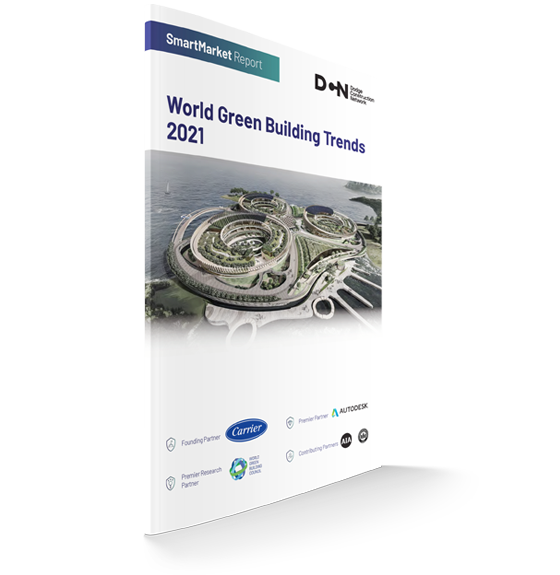by Brianna Crandall — November 17, 2021 — The U.S. Green Building Council (USGBC) has announced the results of Dodge Data & Analytics’ 2021 World Green Building Trends report, of which USGBC is a contributing partner. The new report demonstrates that despite the challenges of the last two years, commitments to increase green building efforts continues to remain strong. The report shows that green building continues to remain a global priority, driven by extreme events and despite rising concerns like the Covid-19 pandemic — and perhaps in part because of the pandemic concerns.

Despite pandemic challenges, report shows increased commitment to green building strategies to reduce energy, cut carbon, and now make buildings healthier
Peter Templeton, president and CEO, USGBC, stated:
The World Green Building Trends report underscores the increasing importance that governments, corporations and institutions are placing on green buildings for our climate, health and economy. As USGBC and our partners participate in COP this week, the benefits of LEED green buildings stand out as top-of-mind solutions helping organizations meet commitments and maximize efficiency, resilience, health and sustainability across their buildings.
The 2021 World Green Building Trends report highlights the various factors that are driving commitments to green building. Industry professionals surveyed cite both social and financial reasons for increasing their green building efforts, with top reasons including lowering operating costs, lowering carbon emissions, reducing energy and water consumption, market demand, building healthier buildings, living up to internal corporate commitments, and that it’s the “right thing to do.”
Respondents stated that they have shifted their focus on strategies to specifically address reducing energy consumption and the carbon footprint of building projects, with creating net-zero/net-positive buildings as the top priority. This reflects the recognition that only by making the built environment carbon-neutral can the goal to minimize the impacts of climate change be achieved.
The findings also demonstrate a compelling business case for building green, according to statistics cited by USGBC. The average reduction in operating costs for the first 12 months in a new green building is 10.5%, and five-year costs savings are 16.9%. Green renovations and retrofits have even greater performance globally, at 11.5% and 17% respectively. Owners also report that new and retrofit green building projects see an increase in asset value by more than 9%.
Additionally, the report shows how the pandemic has had an impact on the green building sector, with many survey respondents noting the ways in which the built environment can encourage or discourage the spread of airborne diseases like Covid-19. Respondents noted that messaging about increasing filtered air exchange in buildings directly influenced their choice of HVAC system, while social distancing impacted building design.
Other findings of the report include:
- Over half of those managing a majority of green projects plan to incorporate resilience strategies into their projects in the next five years.
- Most respondents (82%) are at least aware of the concept of “embodied carbon” — emissions from manufacture, transportation, installation, maintenance and disposal of building materials — with contractors and owners less familiar with embodied carbon than architects and engineers.
- The vast majority (79%) of those building green use at least one metric to track green building performance, an increase of five points since 2018.
- About half of respondents engage in green renovation/retrofit projects, with most investors engaged in this work.
The report was published by the Dodge Construction network, with USGBC as a contributing partner in the report. More than 1,200 industry professionals, including engineers, architects/designers, contractors, owners, developers, inventors and consultants around the world, were surveyed for the report.
The full World Green Building trends 2021 report can be found on the Dodge Data & Analytics website.





